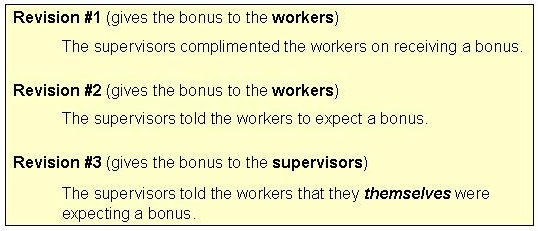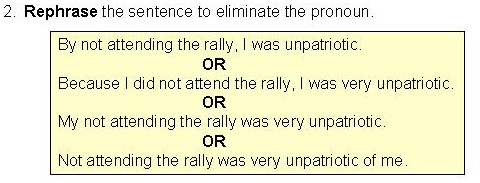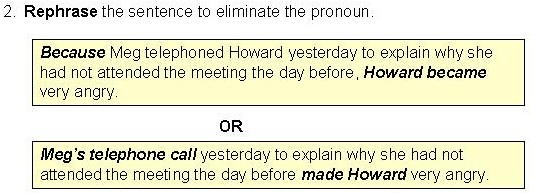What Should Replace the Underlined Pronoun to Correct the Pronoun Shift Error?
Usage - Pronoun Reference
A pronoun is a word used to stand up for (or accept the place of) a substantive .
A pronoun should refer clearly to one, clear, unmistakable noun coming before the pronoun. This noun is called the pronoun�s antecedent.
Unfortunately, it is very easy to create a sentence that uses a pronoun WITHOUT a clear, unmistakable substantive ancestor.
Example:

The pronoun it does not have a clear substantive ancestor.
Every bit a event, the reader cannot know for certain whether Mabel sold the disk or the cabinet. The pronoun reference is faulty here because the pronoun it has 2 antecedents.
Such errors, called FAULTY or VAGUE PRONOUN REFERENCE, can confuse readers and obscure the intended meaning.
There are three major pronoun reference errors.
Error #1: Likewise MANY ANTECEDENTS
A pronoun should accept only one antecedent. That ancestor should be articulate and unmistakable.
Look at this judgement:

Anyone who reads this sentence would not know which item was to exist fixed.
Does it refer to the radio or the car? The answer is unclear.
In the to a higher place example, faulty pronoun reference occurs because the pronoun it has two possible noun antecedents.
To set up the judgement, substitute a substantive for the pronoun.

Here is another example of faulty pronoun reference caused past more than one noun antecedent:

The pronoun reference is unclear: Who will get the bonus - the supervisors or the workers? They could refer to either group.
In this example, the all-time mode to fix the pronoun reference trouble is to rephrase the sentence.

Error #ii: Hidden ANTECEDENTS
Faulty pronoun reference errors as well occur when the pronoun's antecedent functions as an adjective rather than a substantive.
In such cases, the true antecedent is "subconscious" or obscured from the reader because it has been subordinated to another noun.

The reader of this sentence might remember that the dish was being eaten because dish appears to be the antecedent for the pronoun information technology .
Plain, people do not eat dishes. What this writer ways to say is, "We were tired of eating candy ."
All the same, processed cannot exist the antecedent for it because candy , situated in front end of the substantive dish , is acting like an describing word. But nouns can exist antecedents.

Hither is another example of faulty pronoun reference caused by a subconscious antecedent:
![]()
Evidently, she refers to Mary since a house would NOT be able to reply a phone.
However, Mary'southward modifies firm - Mary'southward is a hidden antecedent and, thus, is non clear.


Nevertheless another manner to repair this error is to rephrase the judgement.

Error #3: NO Ancestor AT ALL
Another kind of faulty / vague pronoun reference trouble occurs when writers use a pronoun without giving the pronoun any antecedent at all.
Example:
![]()
In this instance, the pronoun they has NO noun antecedent to which information technology tin refer.


Here is some other example of a pronoun without any ancestor at all.
![]()
In this example, the pronoun it has no antecedent to which it can refer.
The reader knows that Mrs. Smith is "wealthy," only it cannot refer to wealthy considering wealthy is not a noun.
There are at least two ways to repair this error.

With a substantive (wealth) in the place of the pronoun (it), no antecedent is needed.

Now the pronoun it has a articulate noun antecedent: money .
Hither is another example of a pronoun without any antecedent.
![]()
It , which appears at the very beginning of the sentence, has no noun antecedent at all. In addition, the structure It says in the paper is unnecessarily wordy.
We can repair this error by writing a more Direct version of "It says in the paper."
Example:
![]()
Another way to repair the "It says in the paper" error is to rephrase this part of the sentence.
Example:
![]()
Both methods of repairing this faulty/vague pronoun mistake eliminate the pronoun and, thus, eliminate the need for an antecedent.
Below, another example shows how this error in pronoun reference occurs when a pronoun is used to stand for (refer to) a whole group of words INSTEAD OF one articulate noun antecedent.

The word which has no single, clear antecedent.
Instead, information technology refers to the entire clause - "I did non attend the rally."
Yet, a pronoun must always refer to a single, articulate, unmistakable Substantive Ancestor.
We can repair this error in at least two ways.


Here is another case of faulty pronoun reference where a pronoun is asked to refer to a whole group of words instead of a articulate, unmarried noun antecedent.

The problem here is This . Its antecedent is the entire preceding judgement.
The reader cannot exist certain whether Howard is very aroused because:
- one. Meg telephoned ,
- 2. Meg telephoned yesterday , or
- 3. Meg had non attended the meeting the solar day before .
At that place are at least two ways to repair this mistake and create a articulate ancestor for this :


** Watch out for "this" and "which" pronouns. Ofttimes they are used incorrectly and create faulty or vague pronoun reference problems. **
Source: https://www.towson.edu/ows/proref.htm
0 Response to "What Should Replace the Underlined Pronoun to Correct the Pronoun Shift Error?"
Post a Comment